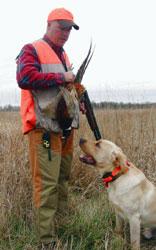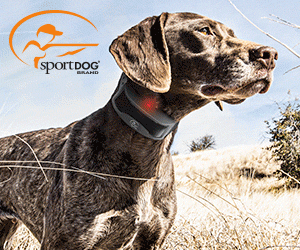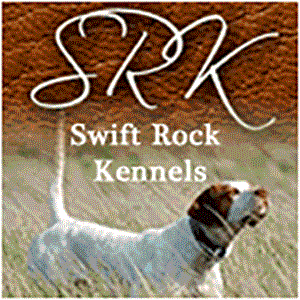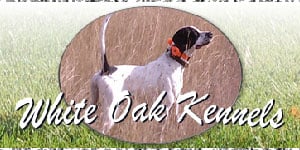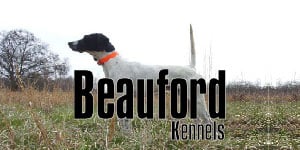ALL ABOUT RETRIEVER TRAINING DUMMIES
from our partner at SportDOG Brand
Posted 06/12/2023
Training dummies are a staple of a good retriever training program. Whether you call them dummies or bumpers doesn’t matter, but what does matter is picking the right style and color to fit your training situations.
Dummies come large or small and in plastic or canvas. They also come in a variety of colors, the main ones being white, black, black/white, and orange.
At a glance, it wouldn’t seem that there are many considerations in picking a training dummy. After all, any retriever worth the paper its pedigree is printed on thinks that chasing down and bringing back just about any object is the most fun a dog could ask for. While that may be true, your training sessions will benefit from some forethought when it comes to using and selecting dummies.
CONTRAST, CONTRAST, CONTRAST!
The first rule of setting up worthwhile retrieving, or “marking,” drills is that you have to give your dog every opportunity to see the throw. Otherwise, what’s the point?
Always consider the background and try to envision the way your dog is going to see the throw as you set up marking drills. If you’re throwing against a dark background such a tree line, you should obviously be using white. If the throw is going to take the dummy up against a bright sky at midday, a black/white dummy should offer that much-needed contrast that will help your dog see it clearly.
Keep the all-important contrast factor in mind and you can’t go wrong. When you’re working on building a dog’s confidence, white is going to get the nod almost every time because your dog won’t have to work real hard at finding the dummy when it gets close to it. As for water training, nothing beats the way a white dummy practically sparkles on the water if you’re running your dog with the sun behind you. That can be a big motivator when you’re working on longer retrieves.
A lot of people don’t understand why their dog can’t easily see an orange dummy, even in short grass. It’s because to a dog’s eyes, an orange dummy comes across as gray and therefore blends into most ground cover. Orange is great during training for blind retrieves when you want to be sure your dog can’t see the object you sent it to retrieve. But I should also add that orange does have a place in marking drills. It seems to provide plenty of contrast when thrown against a bright sky, and in that situation may even pop better than white.
MATCHING DUMMY SIZE TO DOG
It’s important to start out with a smaller-diameter dummy during puppy training. You want to encourage your pup to grab it in the middle. When a dummy is too large for a dog to carry comfortably, it will tend to grab it by the throwing rope or on the skinny part near the grommet, and that can lead to bad habits that become hard to correct.
Speaking of the throwing rope, I suggest leaving the rope off of puppy-sized dummies in the early stages of training. That’s one less variable to contend with.
One factor that I think is often overlooked as a dog gets bigger is that you need to make sure it gets used to regularly handling a larger dummy. Whether it’s plastic or canvas, a fatter dummy that fills the dog’s mouth better means less chance that they’ll be able to bobble it in their mouth and chomp on it, which can lead to hardmouth. Plus, gamebirds such as ducks and pheasants are pretty big, so this is a great example where you want to follow the “practice like you want to play” axiom during training.
CANVAS OR PLASTIC?
Most trainers go to the field well-stocked with both plastic and canvas-covered dummies. Plastic works for pretty much any situation. When it comes to providing color contrast, all the earlier mentioned considerations apply to either type. Canvas, however, provides some versatility because it bears more resemblance to a real bird. Let me explain.
It’s important to train with real birds when you can, but let’s face it, live or fresh-killed ducks and pheasants are not always available and can get expensive. A large canvas dummy can fill the void. A pair of duck or pheasant wings secured to a canvas dummy with electrical tape makes a bulky, weighty object, and the wings add some real-bird texture. Altogether, the result is an extra dose of excitement during training drills.
An extra advantage of canvas dummies is that they will let you know if your dog is developing a mouthing problem. If your canvas dummies are full of deep teeth marks or you see that your dog is puncturing the canvas, it’s not much of a stretch to imagine what will happen with real birds. If you see evidence that hardmouth is becoming a problem, it’s time to get with a professional trainer who can revisit force-fetching and find a fix.
SCENT CONSIDERATIONS
While the emphasis with training dummies is the all-important aspect of marking throws, there are times when you might want to work on scent-related drills. Again, nothing beats real birds, but a dummy containing bird scent can make a decent substitute.
If you want to give your dog an advantage in using its nose to find plastic dummies, apply some commercially made wax-based scent. I like wax as opposed to liquid scent because the wax will retain the scent longer and therefore needs less refreshing.
Canvas dummies are excellent for absorbing and holding liquid scent. If you’re working on trailing drills (for pheasant-hunting practice for example), a canvas dummy laced with liquid scent and dragged through light cover should give a dog plenty to work with.
A retrieving dummy is as simple to use as it is valuable. Putting some thought into what styles, sizes and colors you’re using will help you build a more successful retriever.
Dummies come large or small and in plastic or canvas. They also come in a variety of colors, the main ones being white, black, black/white, and orange.
At a glance, it wouldn’t seem that there are many considerations in picking a training dummy. After all, any retriever worth the paper its pedigree is printed on thinks that chasing down and bringing back just about any object is the most fun a dog could ask for. While that may be true, your training sessions will benefit from some forethought when it comes to using and selecting dummies.
CONTRAST, CONTRAST, CONTRAST!
The first rule of setting up worthwhile retrieving, or “marking,” drills is that you have to give your dog every opportunity to see the throw. Otherwise, what’s the point?
Always consider the background and try to envision the way your dog is going to see the throw as you set up marking drills. If you’re throwing against a dark background such a tree line, you should obviously be using white. If the throw is going to take the dummy up against a bright sky at midday, a black/white dummy should offer that much-needed contrast that will help your dog see it clearly.
Keep the all-important contrast factor in mind and you can’t go wrong. When you’re working on building a dog’s confidence, white is going to get the nod almost every time because your dog won’t have to work real hard at finding the dummy when it gets close to it. As for water training, nothing beats the way a white dummy practically sparkles on the water if you’re running your dog with the sun behind you. That can be a big motivator when you’re working on longer retrieves.
A lot of people don’t understand why their dog can’t easily see an orange dummy, even in short grass. It’s because to a dog’s eyes, an orange dummy comes across as gray and therefore blends into most ground cover. Orange is great during training for blind retrieves when you want to be sure your dog can’t see the object you sent it to retrieve. But I should also add that orange does have a place in marking drills. It seems to provide plenty of contrast when thrown against a bright sky, and in that situation may even pop better than white.
MATCHING DUMMY SIZE TO DOG
It’s important to start out with a smaller-diameter dummy during puppy training. You want to encourage your pup to grab it in the middle. When a dummy is too large for a dog to carry comfortably, it will tend to grab it by the throwing rope or on the skinny part near the grommet, and that can lead to bad habits that become hard to correct.
Speaking of the throwing rope, I suggest leaving the rope off of puppy-sized dummies in the early stages of training. That’s one less variable to contend with.
One factor that I think is often overlooked as a dog gets bigger is that you need to make sure it gets used to regularly handling a larger dummy. Whether it’s plastic or canvas, a fatter dummy that fills the dog’s mouth better means less chance that they’ll be able to bobble it in their mouth and chomp on it, which can lead to hardmouth. Plus, gamebirds such as ducks and pheasants are pretty big, so this is a great example where you want to follow the “practice like you want to play” axiom during training.
CANVAS OR PLASTIC?
Most trainers go to the field well-stocked with both plastic and canvas-covered dummies. Plastic works for pretty much any situation. When it comes to providing color contrast, all the earlier mentioned considerations apply to either type. Canvas, however, provides some versatility because it bears more resemblance to a real bird. Let me explain.
It’s important to train with real birds when you can, but let’s face it, live or fresh-killed ducks and pheasants are not always available and can get expensive. A large canvas dummy can fill the void. A pair of duck or pheasant wings secured to a canvas dummy with electrical tape makes a bulky, weighty object, and the wings add some real-bird texture. Altogether, the result is an extra dose of excitement during training drills.
An extra advantage of canvas dummies is that they will let you know if your dog is developing a mouthing problem. If your canvas dummies are full of deep teeth marks or you see that your dog is puncturing the canvas, it’s not much of a stretch to imagine what will happen with real birds. If you see evidence that hardmouth is becoming a problem, it’s time to get with a professional trainer who can revisit force-fetching and find a fix.
SCENT CONSIDERATIONS
While the emphasis with training dummies is the all-important aspect of marking throws, there are times when you might want to work on scent-related drills. Again, nothing beats real birds, but a dummy containing bird scent can make a decent substitute.
If you want to give your dog an advantage in using its nose to find plastic dummies, apply some commercially made wax-based scent. I like wax as opposed to liquid scent because the wax will retain the scent longer and therefore needs less refreshing.
Canvas dummies are excellent for absorbing and holding liquid scent. If you’re working on trailing drills (for pheasant-hunting practice for example), a canvas dummy laced with liquid scent and dragged through light cover should give a dog plenty to work with.
A retrieving dummy is as simple to use as it is valuable. Putting some thought into what styles, sizes and colors you’re using will help you build a more successful retriever.
Related Aritlces
Training Your Retriever for Double Duty
If you own a waterfowl dog, chances are that sooner or later you're going to ask it to perform upland duty. It might be a pheasant hunt as a sideline to your Dakota duck hunt, or maybe an afternoon of quail hunting after a morning goose hunt. Most retrievers handle their second job pretty well. You can help your dog perform that job even better.





